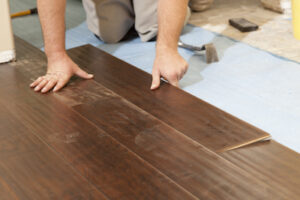What to Consider When Choosing The Perfect Home Flooring?
Home remodeling is incomplete without the installation of new floors. A wide variety of flooring materials, styles, and textures are there to pick from, to create a balance between style and practicality in the interiors.
One can be indecisive about the selection of flooring because of the vast availability as well as distinctive requirements. Whether indoors or outdoors, you have to be mindful about selecting flooring treatments for the best home upgrade. And we’ve come up with a handful of tips and tricks to proceed with the home floor selection process, suggested by the Best Flooring Company.

Essential Considerations to Choose Floorings For Home
When deciding on the flooring treatment, one must take these factors into account.
1. Decide What You Want
Whenever you go to select flooring treatment, first of all, think about the style and layout of your interior. That’s because every flooring type comes with different properties. Besides the area of application, flooring trends change continuously with time, so it’s important to settle for a timeless choice. Also, your chosen flooring will be compatible with the subflooring.
2. Choosing the Perfect Material
When it comes to flooring, plenty of types are there to match your interior design. Laminate, vinyl, wood, hardwood flooring, parquet, concrete, tile, stone, and cork flooring are some of the popular choices. Each of these flooring types differs in practical attributes, appearance, and durability.
3. Consider the Style
The style, design, pattern, and color of the floors can change the overall vibe of a place. For wooden flooring, you get a range of textures options that can be either smooth or grainy. The patterns and finishing of each flooring are distinct. Laminate, epoxy, and terrazzo floorings are also good choices for contemporary interiors.
4. Think About Functionality
Functionality must be the topmost aspect to keep in mind when choosing flooring for your home. Aside from style and design selection, pick flooring that can benefit you functionally. Think about the daily foot traffic in your place and pick a flooring treatment heavy-duty enough to bear the intensity. In addition to being wear and tear-resistant, the flooring must be resistant to UV rays, stains, mold, and temperature changes. Besides, insulation is another factor to look for.
5. Stability And Durability
The structural stability of a flooring can be determined by its materials or number of layers. Protective and wear layers give dimensional support to flooring. Ask the manufacturer about the extent of moisture resistance offered by different floorings. Invest in flooring that can help you make the most out of your money and can continue to serve you for prolonged time periods.
6. Maintenance Needs
Not every floor is easy to maintain and take care of. Some floors are not spill/stain resistant, or pet-friendly. Therefore, based on your home’s daily wear and tear, pet damage, and other usage intensities, choose flooring that is easy to clean.
7. Installation
The method to install the floors differ with the type you choose, such as glue down, nail down, or screw down methods. Installation costs will also be included until and unless you decide to install the floors yourself.
8. Flooring Costs
No matter what type, style, or size you choose for the flooring, it’s important to consider the budget you have. Flooring treatments are available in multiple choices ranging from low-cost options to incredibly expensive ones. Set your budget before browsing for flooring treatments.
9. Safety
Safety is a significant concern, especially if you have children, elderly family members, or pets at home. Look for flooring materials that offer good slip resistance, especially in areas prone to moisture like bathrooms and kitchens. Certain materials, such as tile and vinyl, have anti-slip properties, making them suitable for high-moisture areas. Additionally, if you or your family members have allergies, consider flooring materials that are hypoallergenic and easy to clean to minimize allergen buildup.
10. Environmental Impact: Sustainable Flooring Options
With growing awareness about sustainability, many homeowners are opting for eco-friendly flooring materials. If reducing your environmental footprint is important to you, consider materials such as bamboo, cork, or reclaimed wood. These options are renewable and often produced using environmentally friendly manufacturing processes. Additionally, look for flooring materials that have low VOC (volatile organic compound) emissions to ensure the air quality in your home remains healthy.
Pro Tip:
The expert advice for selecting the ideal flooring for a home is to choose the one that will increase the value of your home. The resale can be significantly enhanced with the right selection of flooring treatment.

Frequently Asked Questions (FAQs)
Can I install hardwood flooring in my basement?
It is generally not recommended to install hardwood flooring in basements due to the risk of moisture damage. Basements have higher humidity levels, which can cause the wood to warp or buckle. Instead, consider alternative flooring options like vinyl, laminate, or carpet, which are more suitable for below-grade spaces.
Are there eco-friendly alternatives to traditional carpet flooring?
Yes, there are eco-friendly alternatives to traditional carpet flooring. You can opt for natural fiber carpets made from materials like wool or sisal. These carpets are biodegradable, renewable, and have low VOC emissions. Another option is carpet tiles, which are modular and allow for easy replacement of individual tiles, reducing waste.
Can I install tile flooring over the existing vinyl flooring?
In some cases, it is possible to install tile flooring over existing vinyl flooring. However, proper surface preparation is essential. The existing vinyl flooring should be in good condition, with no signs of peeling or bubbling. It’s recommended to consult with a professional installer to ensure the proper installation and avoid potential issues.
Is underfloor heating compatible with all types of flooring?
No, not all types of flooring are compatible with underfloor heating systems. Materials like tile, stone, and concrete are excellent conductors of heat and work well with underfloor heating. On the other hand, materials like solid hardwood or laminate may not be suitable as they can warp or shrink when exposed to heat. It’s important to consult with a heating specialist to determine the best flooring options for your underfloor heating system.
How long does it take to install hardwood flooring?
The installation time for hardwood flooring can vary depending on factors such as the size of the area, the complexity of the installation, and the type of hardwood used. On average, installation can take anywhere from a few days to a couple of weeks. It’s recommended to work with a professional installer who can provide a more accurate estimate based on your specific project.
Can I use laminate flooring in high-traffic areas?
Yes, laminate flooring is known for its durability and is suitable for high-traffic areas. It is designed to withstand daily wear and tear and is resistant to scratches and stains. However, it’s important to choose high-quality laminate flooring and follow proper maintenance guidelines to ensure its longevity in high-traffic areas.
In Conclusion
Selection of perfect flooring for the home can be challenging and you have to think about various crucial factors. When you opt for new floorings, think about your interior styling requirements to choose a complementing design. Plan on your budget and choose the type, style, and design accordingly.
The functional requirements of comfort, insulation, strength, stability, and resistance against moisture are some other important factors to consider. Besides that, you have to be mindful of the maintenance requirements and installation costs.
